As an Amazon Associate KitchenwareSets.com earns from qualifying purchases.
13 Brilliant Galley Kitchen Ideas To Maximize Your Space
Is your galley kitchen feeling more like a hallway than a home? You’re not alone in that narrow, tunnel-like space.
A galley kitchen is a long, efficient layout with two parallel walls. The main problem is they can often feel cramped, dark, and cluttered. This struggle for space is a common frustration in many apartments.
The best galley kitchen ideas maximize space by using vertical storage, smart lighting, and light colors to make the room feel wider and brighter. This guide will show you 13 brilliant ways to transform your small kitchen. You’ll discover how to create a space you truly love to be in.
Is Your Galley Kitchen Feeling More Like a Hallway?
Walking into a galley kitchen can sometimes feel like stepping into a tunnel. The parallel countertops, while efficient, can create a cramped feeling, especially in a small apartment. You might be struggling with shadowy workspaces under the cabinets, insufficient storage that leads to cluttered counters, and a general feeling that the walls are closing in. This is a common challenge, but it’s not a design flaw—it’s an opportunity for clever solutions.
A galley kitchen is a long, narrow kitchen layout featuring two parallel walls with countertops and cabinets. Named after the compact kitchens on ships, this design is highly efficient for small spaces. It creates a tight “work triangle” between the sink, stove, and refrigerator, minimizing steps during cooking. The key is to embrace this efficiency while using design tricks to overcome the feeling of being confined. We’ve gathered 13 brilliant, actionable ideas that solve these specific problems, many of which are budget-friendly and perfect for renters.
13 Brilliant Galley Kitchen Ideas To Maximize Your Space
Ready to transform your kitchen from cramped to clever? This list is packed with a mix of ideas, from quick weekend updates perfect for renters to more involved projects for homeowners. Each suggestion is specifically designed to tackle a core galley kitchen problem: making the space feel wider, brighter, and far more organized. We’ll explore everything from smart storage tipss to visual tricks that expand your space without moving a single wall.
1. Go Vertical with Wall-Mounted Shelving
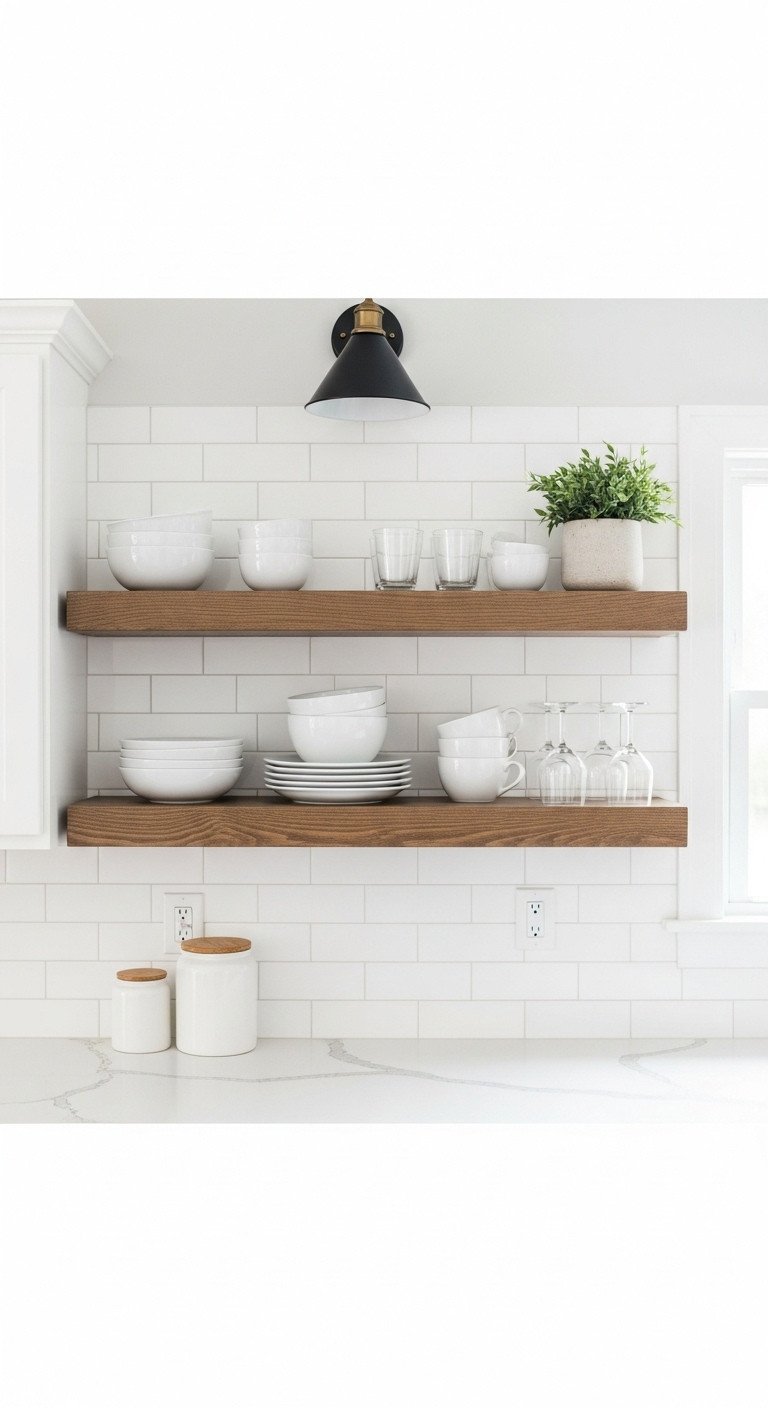
Pin this space-saving idea to your ‘Kitchen Goals’ board!
Bulky upper cabinets can make a narrow kitchen feel heavy and closed-in. Replacing them with open, wall-mounted shelving is a fantastic way to create a sense of airiness. Vertical storage draws the eye upward, making the room feel taller, while open shelves reduce the visual bulk, making the entire space feel wider.
Materials Needed:
- High-quality floating shelf kit with heavy-duty brackets rated for at least 30 lbs
- Stud finder
- Power drill with appropriate drill bits
- Level
- Pencil
- Measuring tape
Step-by-Step Directions:
- Decide on the placement. Use painter’s tape to visualize where the shelves will go. Ensure they are high enough to not interfere with countertop work.
- Use the stud finder to locate the wall studs. Mark their locations lightly with a pencil. Securing shelves to studs is crucial for stability.
- Hold the first bracket against the wall over a stud mark. Use the level to ensure it’s perfectly straight. Mark the screw holes with a pencil.
- Drill pilot holes on your marks.
- Secure the bracket to the wall using the screws provided. Repeat for all brackets.
- Slide the wood shelf onto the secured brackets and secure it according to the manufacturer’s instructions.
- Style your shelves with everyday dishes, glasses, or spices to combine beauty and function.
Pro-Tip: In a galley kitchen, replacing a bulky upper cabinet on one side with two or three floating shelves instantly makes the space feel wider and more open.
2. Install Under-Cabinet LED Lighting
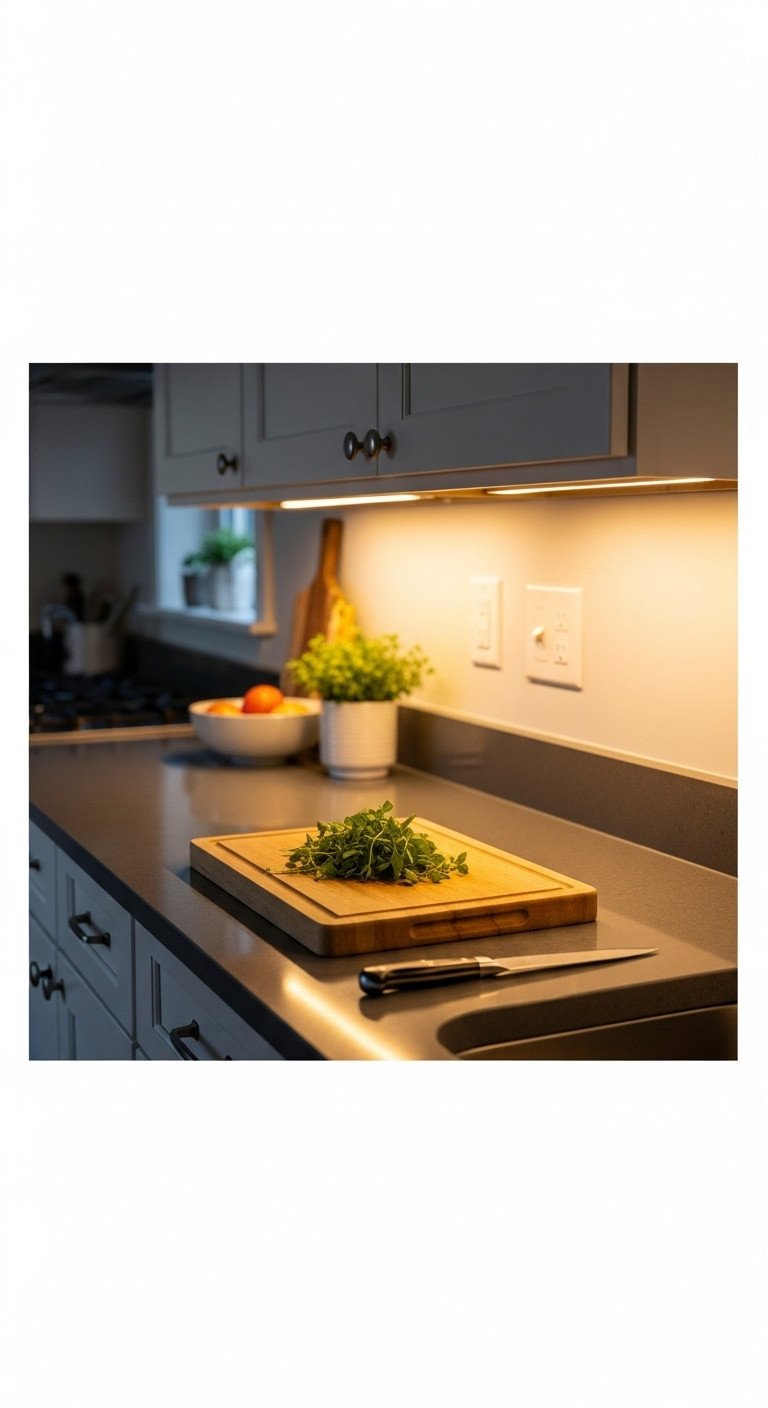
Save this brilliant lighting tips for your kitchen!
One of the biggest culprits of a dreary galley kitchen is poor lighting. A single overhead light often leaves countertops in shadow. Installing low-profile LED strips under your upper cabinets provides brilliant task lighting, eliminating dark corners and making your kitchen safer and more pleasant to work in. This simple addition creates a warm, inviting ambiance.
Supplies Needed:
- A roll of peel-and-stick plug-in LED light strips (choose “warm white” for a cozy feel)
- Alcohol cleaning wipes or a degreasing cleaner
- Small, clear adhesive clips for cord management
- Measuring tape
- Scissors
Quick Steps:
- Thoroughly clean the underside of your upper cabinets where the lights will be placed. Any grease or dust will prevent the adhesive from sticking. Let it dry completely.
- Measure the length of the cabinets you want to illuminate.
- Unroll the LED strip and cut it to your measured length at one of the designated copper cut marks.
- Peel back a small section of the adhesive backing. Starting at one end (closest to your power outlet), press the strip firmly onto the underside of the cabinet. Continue peeling and pressing until the entire strip is attached.
- Run the power cord down the wall behind an appliance or in a corner. Use the clear adhesive clips to neatly secure the cord against the wall or backsplash, making it nearly invisible.
- Plug in the lights and enjoy your beautifully illuminated workspace.
Lesson Learned: This is arguably the single most impactful, low-cost upgrade for any galley kitchen. It not only improves functionality but makes the entire kitchen feel more high-end.
3. Lay Down a Runner Rug
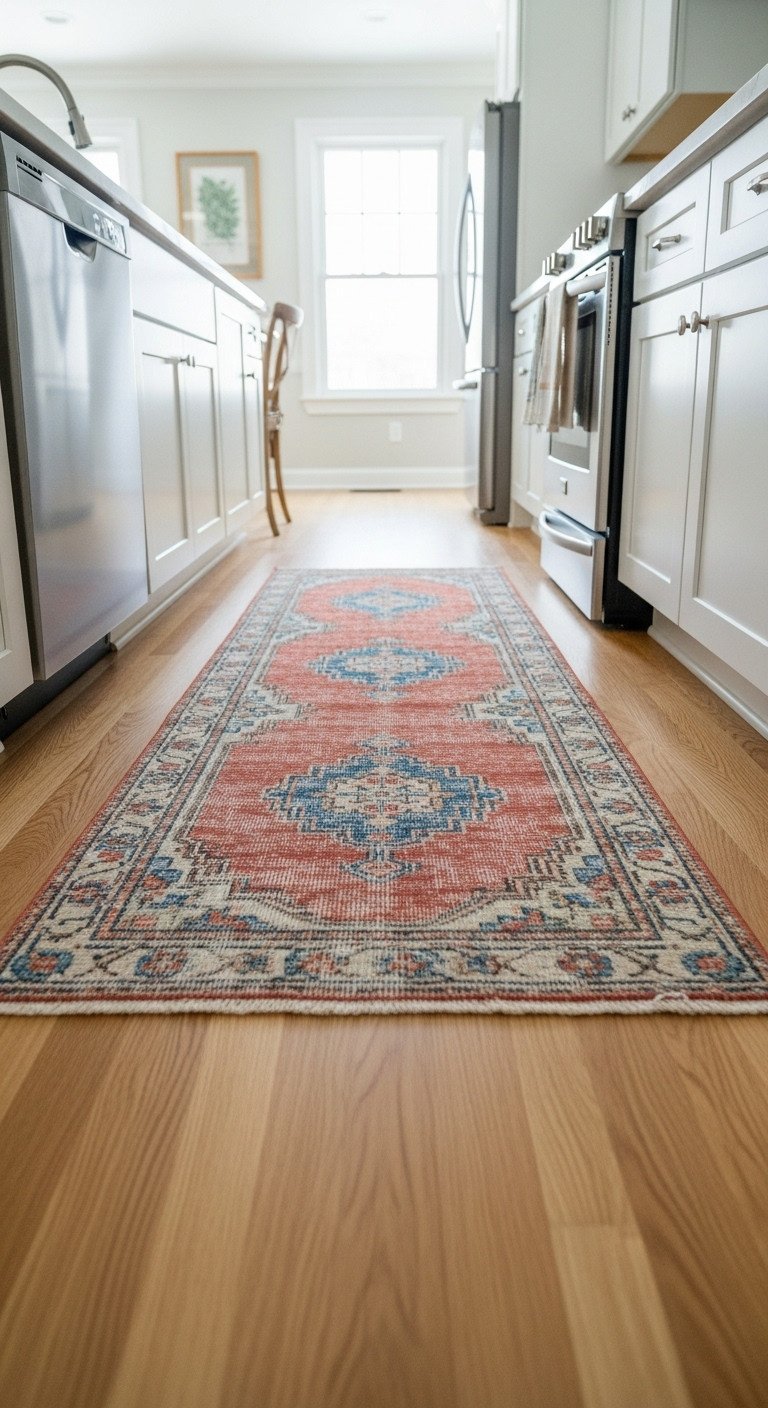
Pin this easy decor idea to add instant personality!
A bare floor can accentuate the long, tunnel-like nature of a galley kitchen. A runner rug is the perfect solution to break up the monotony, add color and pattern, and define the walkway. It adds warmth, texture, and personality, making the floor a feature rather than an afterthought.
Materials Needed:
- Runner rug (typically 2.5 ft wide and 6-10 ft long, depending on your kitchen)
- Non-slip rug pad
- Measuring tape
Step-by-Step Directions:
- Measure the length of the main walkway in your kitchen, from the edge of the fridge to the end of the counter, for example.
- Choose a runner that is slightly shorter than this length, so it doesn’t bunch up against appliances or doorways. The standard width is 2.5 feet, which is perfect for most galley kitchens.
- Select a material. For kitchens, a low-pile, durable, and easily cleanable material is best. Machine-washable runners are a game-changer for this high-traffic area.
- Pick a color or pattern that complements your kitchen’s style. A bold pattern can become a focal point, while a neutral texture adds warmth without overwhelming the space.
- Lay down the non-slip rug pad first, trimming it so it’s an inch or two smaller than the rug on all sides.
- Place your runner on top, ensuring it’s centered in the walkway.
Pro-Tip: A runner with strong longitudinal lines or patterns can visually elongate your kitchen, while a busy, colorful pattern is great for hiding crumbs and minor spills between cleanings.
4. Create a Focal Point on the End Wall
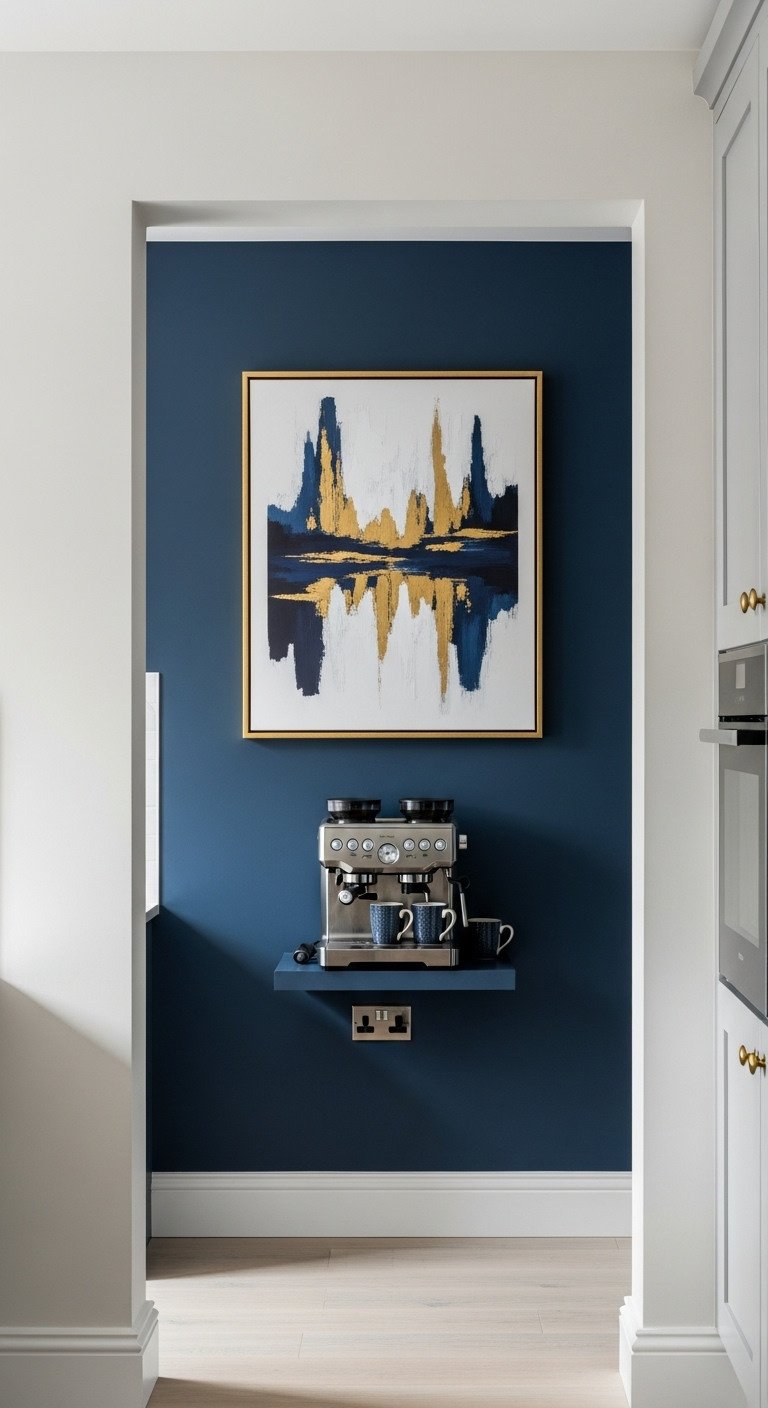
Love this idea? Save it to your ‘Home Decor Inspo’ board!
The blank wall at the far end of a galley kitchen often feels like a dead end. Turning this wall into a destination point with a deliberate focal point draws the eye through the space, making it feel longer and more complete. Whether it’s a bold accent color, a large piece of art, or functional storage, giving this wall a purpose is a powerful design move.
Materials Needed:
- Your chosen focal point: A large piece of framed art, a gallon of bold accent paint, interesting wallpaper, or a shallow pantry cabinet.
- For art: Picture hanging kit, hammer, level.
- For paint: Painter’s tape, roller, paint tray, drop cloth.
- For wallpaper: Wallpaper application kit.
Step-by-Step Directions:
- Choose your strategy. Do you want to add color, texture, or function?
- For Art: Select a piece that is large enough to make a statement—it should take up about two-thirds of the wall’s width. Hang it so the center of the artwork is at eye level (around 57 inches from the floor).
- For an Accent Color: Choose a bold, dramatic color that contrasts with your cabinets. Carefully tape off the edges and paint the entire wall. This creates an illusion of depth, making the kitchen seem longer.
- For Wallpaper: Apply a fun, patterned wallpaper (removable versions are great for renters) to add personality and texture.
- For Function: Install a very shallow, floor-to-ceiling pantry cabinet (like the IKEA PAX, 13″ deep version) to add a massive amount of storage while creating a built-in look.
Lesson Learned: Leaving the end wall blank makes a galley kitchen feel abrupt. Giving it a purpose—whether decorative or functional—makes the entire space feel more intentional and complete.
5. Use a Rolling Kitchen Cart
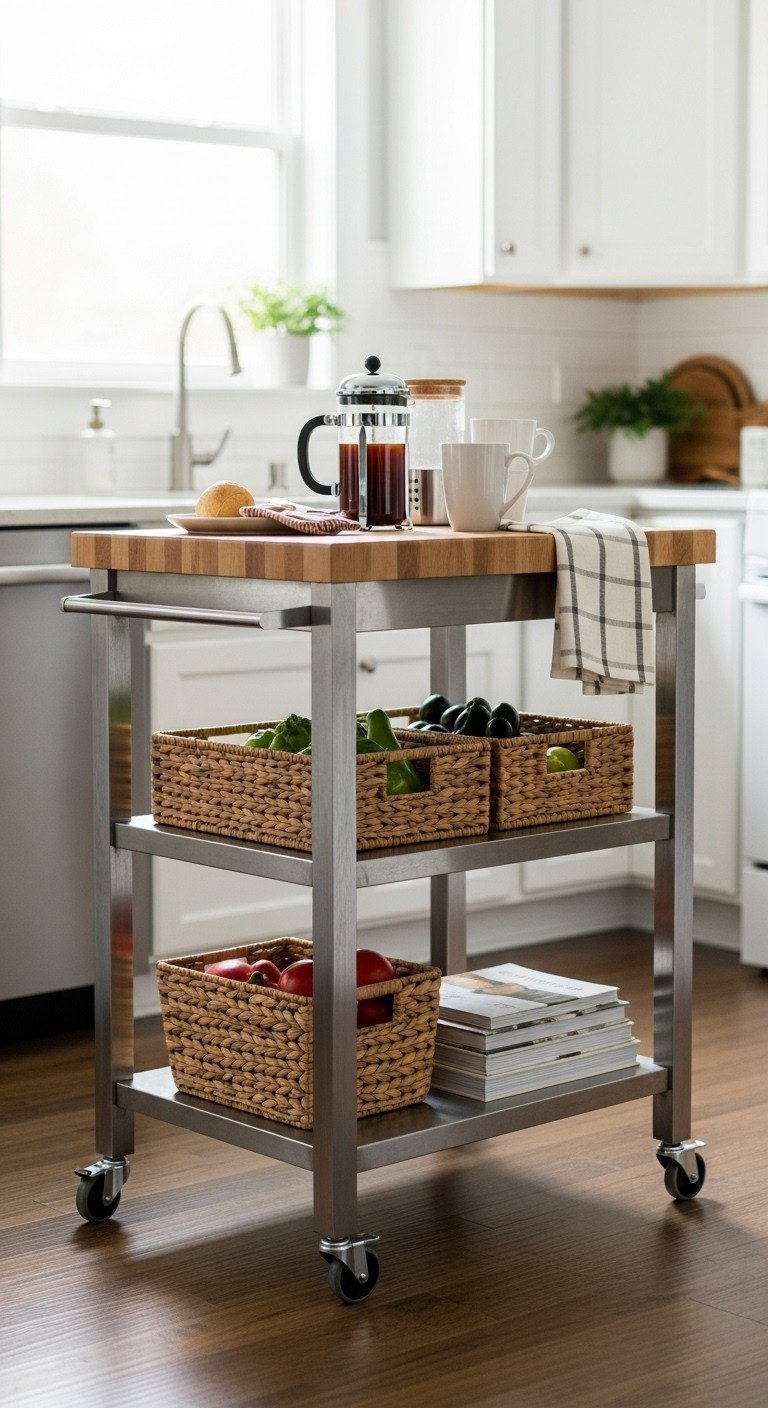
Save this flexible storage solution for your small kitchen!
Dreaming of a kitchen island but don’t have the space? A rolling kitchen cart is the perfect compromise. It provides valuable extra counter space for prep work and flexible, accessible storage on its lower shelves. Best of all, it’s a movable solution that can be pushed out of the way whenever you need more floor space.
Materials Needed:
- A rolling kitchen cart that fits the scale of your space (measure first!)
- Optional: Baskets or bins for organizing the lower shelves
Step-by-Step Directions:
- Measure the width of your kitchen walkway. Subtract at least 36 inches (the minimum comfortable passage space). The result is the maximum depth your cart can be. Look for narrow models, often around 15-20 inches deep.
- Choose a style. Stainless steel offers a professional look, while a painted wood cart with a butcher block top adds warmth.
- Assemble the cart according to the instructions. Ensure the locking casters are installed correctly.
- Position the cart where you need it most. It can live against the end wall as a coffee bar, or be rolled into the center of the kitchen for extra prep space when cooking.
- Use the lower shelves for items that are either bulky (like a stand mixer) or beautiful (like cookbooks and produce baskets).
- When you have guests or need to open both the oven and dishwasher at once, simply roll it out of the way.
Pro-Tip: A rolling cart is the perfect answer to the “Can I put an island in a galley kitchen?” question. It provides all the benefits—extra storage and prep space—without the permanent commitment or obstruction.
6. Upgrade to a Slimline Refrigerator
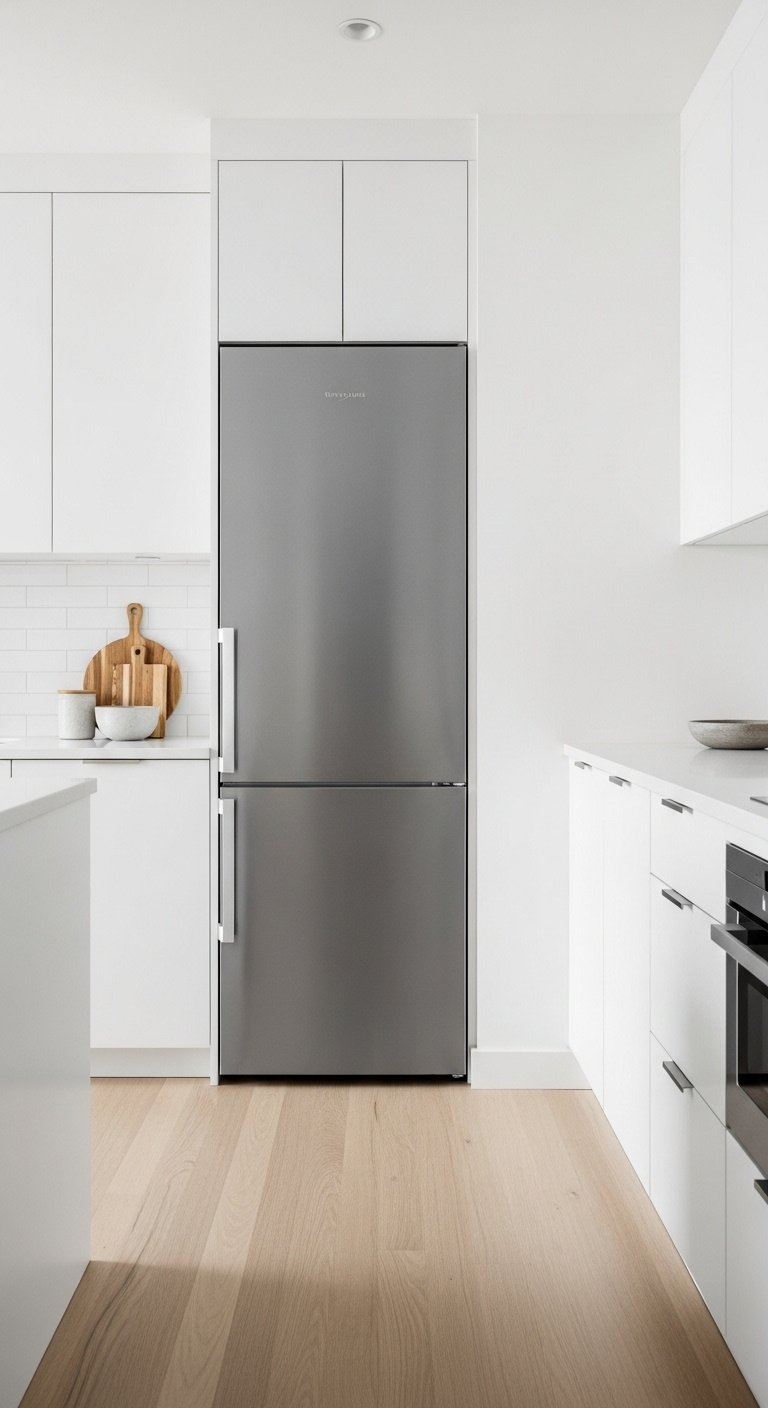
Pin this game-changing idea for gaining space!
A standard refrigerator that juts out several inches past the countertops can create a major bottleneck in a narrow kitchen. Upgrading to a counter-depth or slimline refrigerator is a game-changer. These appliances are designed to sit flush with your cabinetry, creating an uninterrupted visual flow and, more importantly, increasing your valuable aisle space.
Resources Needed:
- Tape measure
- Appliance research (online or in-store)
- Professional delivery and installation service (recommended)
Step-by-Step Directions:
- Measure Carefully: Measure the height, width, and depth of your current refrigerator space. Most importantly, measure the depth of your countertops (typically 24-25 inches).
- Research Options: Look for refrigerators specifically labeled “counter-depth.” These are designed to be around 24-25 inches deep (excluding handles), so they don’t stick out past your cabinets.
- Consider Width: If your space is very narrow, look for “slimline” or apartment-sized models, which are often 24 inches wide instead of the standard 30-36 inches.
- Assess Capacity: Be realistic about your needs. A smaller fridge means less storage. This solution works best for singles, couples, or those who shop frequently.
- Plan for Installation: Swapping refrigerators is a major step. Ensure you have a plan for removing the old one and having the new one professionally installed to connect the water line for an ice maker if needed.
- Enjoy the extra 4-6 inches of clear walkway space. It makes a surprisingly huge difference in how the kitchen feels and functions.
Lesson Learned: While a significant investment, changing from a standard-depth to a counter-depth refrigerator is often the most effective way to physically gain more floor space and improve traffic flow in a tight galley kitchen.
7. Apply a Peel-and-Stick Backsplash
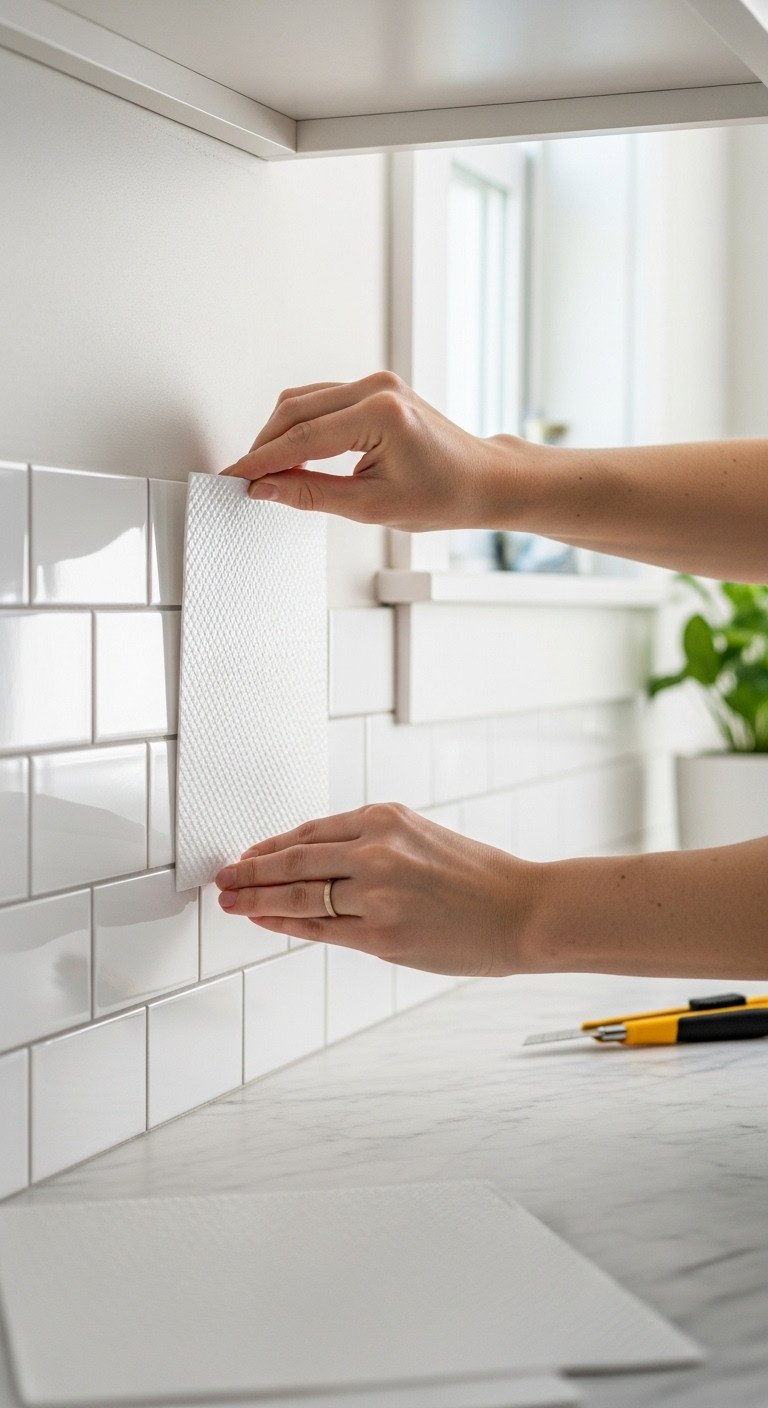
Save this amazing renter-friendly DIY tips!
Want to update an old, boring backsplash without the mess and expense of real tile? A high-quality peel-and-stick backsplash is the perfect DIY project. It’s an affordable, temporary solution that instantly adds style and protects your wall. This is one of the best renter-friendly kitchen upgrades you can make.
Materials Needed:
- High-quality peel-and-stick tile sheets (measure your backsplash area to calculate how many you need, and buy 10% extra)
- Degreasing cleaner
- Measuring tape
- Sharp utility knife or box cutter
- Level or straight edge
Step-by-Step Directions:
- Prep the Wall: This is the most important step. Thoroughly clean your existing backsplash or wall with a degreaser to remove all traces of grease. The tiles will not stick to a dirty surface. Let it dry for at least an hour.
- Plan Your Layout: Start from one corner. Lay the first tile sheet without peeling the backing to see how it fits. Plan your cuts around outlets.
- First Sheet: Peel the backing off the first sheet. Carefully align it with the countertop and corner. Press firmly, smoothing from the center outwards to remove any air bubbles.
- Overlap: Most peel-and-stick tiles have a small overlapping edge. Align the next sheet over this edge to create a seamless, grout-like line.
- Cutting: For cuts around outlets or at the end of a run, measure carefully and mark the back of the tile sheet. Place it on a cutting mat and use a sharp utility knife and a straight edge to make a clean cut.
- Continue applying sheets until the entire area is covered. The transformation is instant!
Pro-Tip: Modern peel-and-stick tiles look incredibly realistic. Choose a style with a slight gloss or texture, like subway or marble hex, to bounce light and help make the kitchen feel brighter.
8. Paint Cabinets a Light, Bright Color
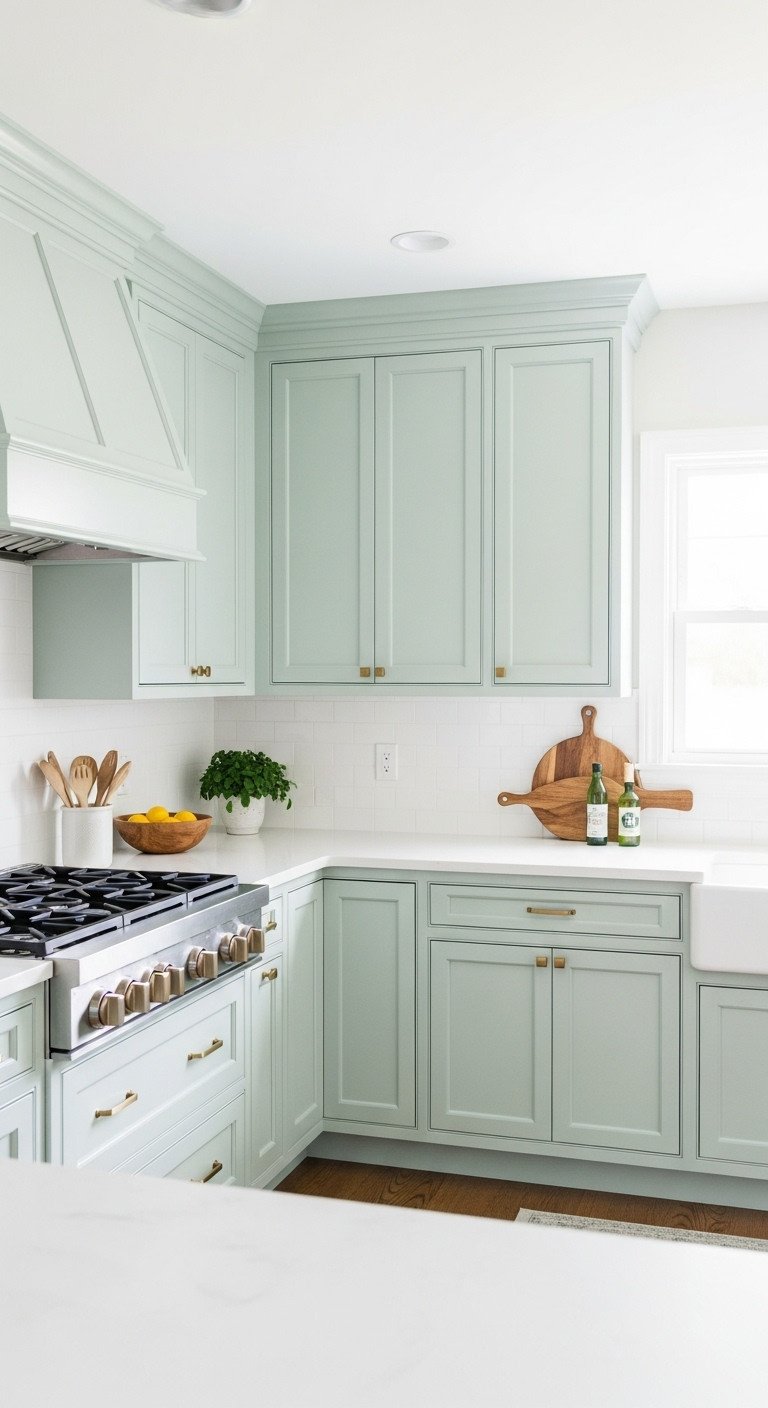
Pin this incredible before-and-after inspiration!
Dark, dated cabinets can absorb all the light in a galley kitchen, making it feel dark and small. Painting them a light, bright color is a high-impact, budget-friendly project that can completely change the feel of the room. Light colors reflect light, making the kitchen feel more airy and spacious, and a durable satin finish is easy to clean.
Materials Needed:
- High-quality cabinet paint or a cabinet refinishing kit
- Krud Kutter or another strong degreaser
- Sandpaper (120 and 220 grit) or a liquid deglosser
- High-adhesion primer
- Mini foam roller and a high-quality angled brush
- Painter’s pyramids or supports
- Painter’s tape
- Drop cloths
Step-by-Step Directions:
- Prep is Everything: Remove all cabinet doors and drawers. Label them with a system (e.g., tape with numbers) so you know where each one goes. Remove all hardware.
- Clean Thoroughly: Scrub every surface you plan to paint with a degreaser. Kitchen cabinets have years of invisible grease buildup that will ruin your paint job.
- Sand/Degloss: Lightly scuff sand all surfaces to remove the glossy finish and give the primer something to grip. Wipe away all dust with a tack cloth.
- Prime: Apply one to two thin, even coats of a high-adhesion primer. This is the key to a durable finish. Let it dry completely according to the can’s instructions.
- Paint: Apply two to three thin coats of your chosen cabinet paint. Use the roller for flat surfaces and the brush for detailed areas. Allow adequate drying time between coats (this is crucial!).
- Cure and Reassemble: Let the doors and drawers cure for several days before reattaching hardware and hanging them. The paint needs time to harden fully to prevent chipping.
Lesson Learned: Don’t rush the process. 80% of a successful cabinet paint job is in the tedious prep work. But the payoff is a kitchen that looks brand new for a fraction of the cost of replacing cabinets.
9. Replace Bulky Hardware
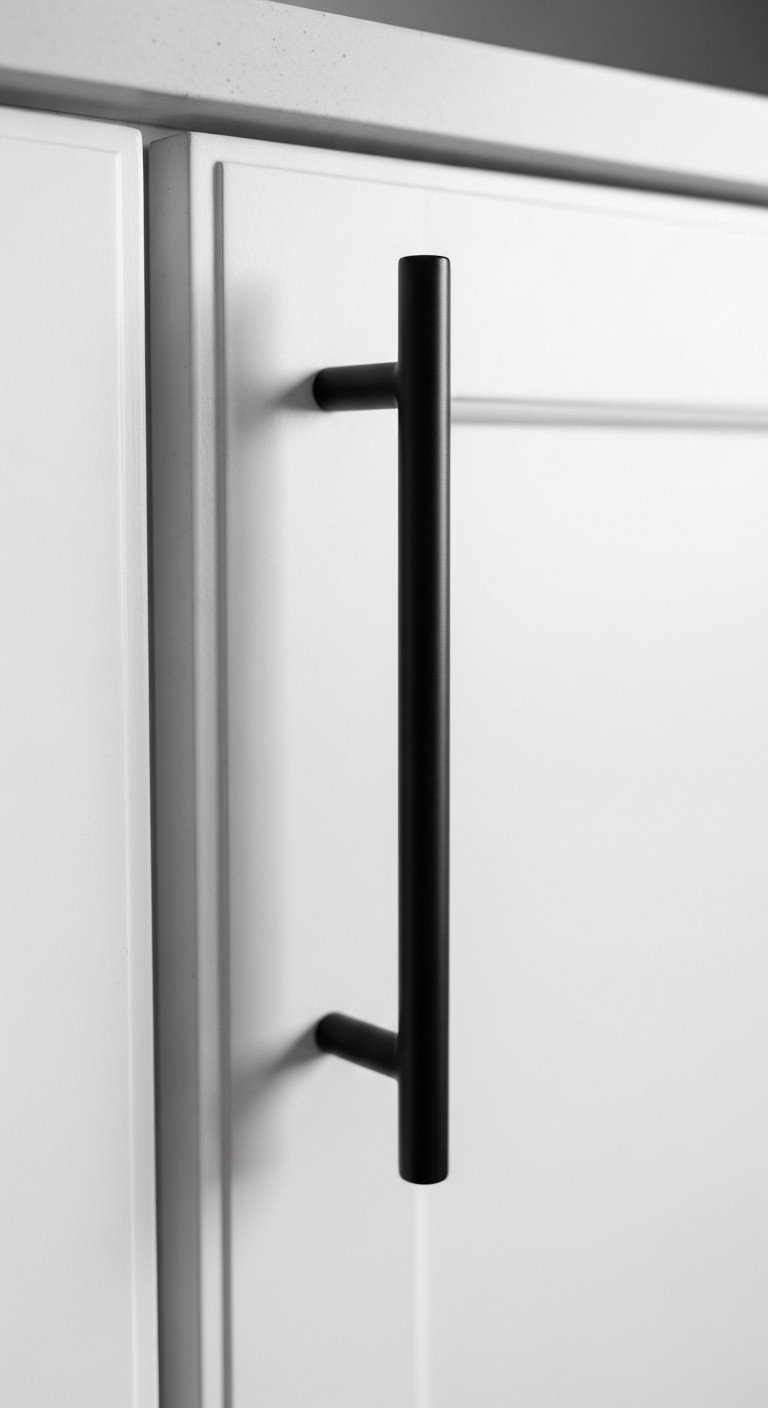
Save this quick and easy kitchen update idea!
It’s amazing what a difference small details can make. Old, bulky, or dated cabinet hardware can be swapped out in minutes for a fresh, modern look. This low-cost, high-impact update is one of the fastest ways to give your kitchen a facelift, and it’s completely renter-friendly (just save the old hardware to switch back).
Materials Needed:
- New cabinet knobs or pulls
- Screwdriver
- Measuring tape or a cabinet hardware jig
- (Optional) Wood filler if changing from knobs to pulls
Step-by-Step Directions:
- Measure First: If you are replacing pulls, measure the distance between the center of the two screw holes. This is your “center-to-center” measurement, and you must buy new pulls with the same dimension.
- Remove Old Hardware: Use a screwdriver to unscrew the old knobs or pulls from the inside of the cabinet doors and drawers.
- Clean the Surface: Clean the area around the screw holes where the old hardware was sitting.
- Install New Hardware: Simply screw the new knobs or pulls into the existing holes. This is a 15-minute update!
- If Changing Styles: If you’re switching from single-hole knobs to two-hole pulls, you’ll need to fill the old hole with wood filler, sand it smooth, touch up the paint, and then use a cabinet hardware jig to drill a new, level second hole.
Pro-Tip: In a narrow galley kitchen, choose hardware that is sleek and low-profile. Avoid bulky knobs or pulls that stick out far, as you’re more likely to snag your clothes on them in the tight space. Bar pulls or finger pulls are excellent choices.
10. Hang a Wall-Mounted Pot Rack
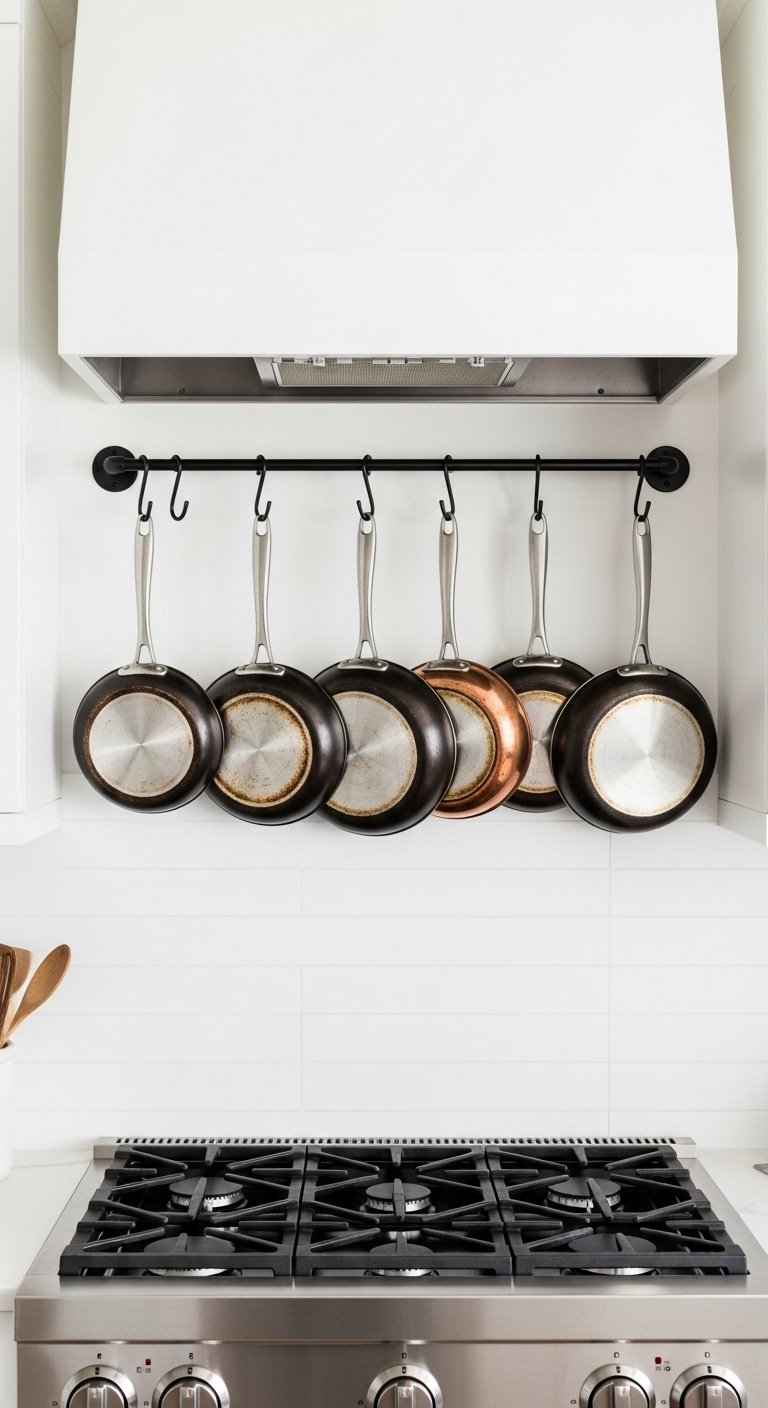
Pin this clever trick for freeing up cabinet space!
Pots and pans are bulky and can eat up an entire base cabinet. A wall-mounted pot rack or kitchen rail system is a brilliant storage tips that frees up that precious cabinet space. It also turns your frequently used items into functional decor, providing easy accessibility and adding a professional, “chef’s kitchen” vibe.
Materials Needed:
- A wall-mounted pot rack or kitchen rail system (like the IKEA KUNGSFORS)
- S-hooks
- Power drill
- Stud finder
- Level
- Pencil
Step-by-Step Directions:
- Choose a Location: The wall space above your stove or along an empty stretch of backsplash is ideal. Ensure it’s high enough not to interfere with cooking but low enough to reach easily.
- Find the Studs: Pots and pans are heavy. You absolutely must mount the rack into wall studs. Use a stud finder and mark the locations.
- Mark Drill Holes: Hold the rack up to the wall, align it with your stud marks, and use a level to make sure it’s straight. Mark where you need to drill.
- Drill and Mount: Drill pilot holes into the studs, then securely screw the rack’s mounting hardware into the wall.
- Hang Your Cookware: Use S-hooks to hang your most frequently used pots, pans, and large utensils.
- Bonus: This not only saves an incredible amount of cabinet space but also adds a professional, “chef’s kitchen” vibe.
Lesson Learned: Don’t be afraid to display functional items as decor. In a small space, everything should earn its keep. A set of matching cookware can look as beautiful as a piece of art when displayed neatly.
11. Create a Pass-Through to an Adjoining Room
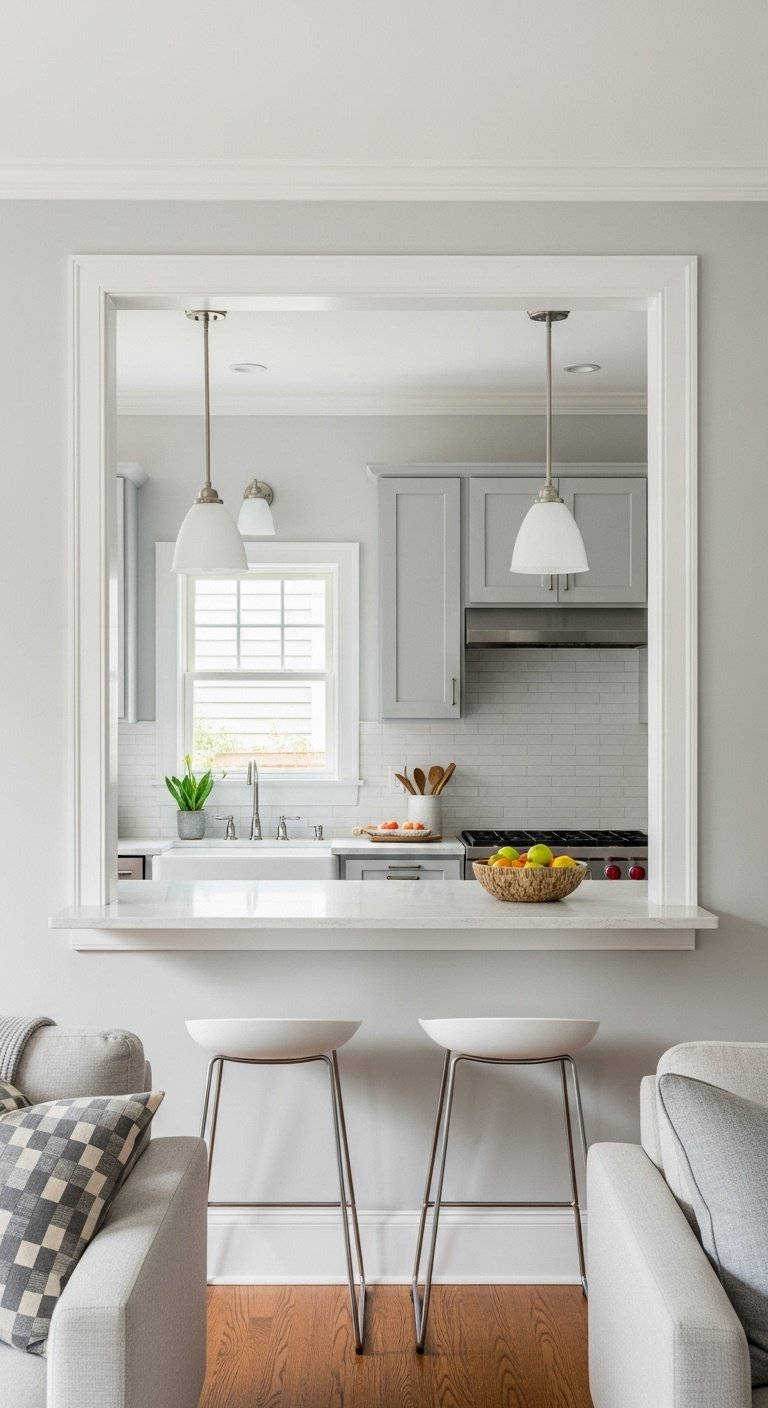
Save this major transformation idea for your future remodel!
If your galley kitchen feels isolated from the rest of your home, creating a pass-through can be a transformative project. By removing the upper half of a non-load-bearing wall, you connect the spaces, share natural light, and create an open-concept feel. Extending the countertop creates a breakfast bar, adding valuable seating and a social hub.
Tools & Materials Needed:
- This is a job for a professional contractor.
- Materials will include framing lumber, drywall, paint, and countertop material.
Step-by-Step Directions:
- Consult a Professional: Before any demolition, hire a licensed contractor or structural engineer to determine if the wall is load-bearing. This is a non-negotiable safety step.
- Design the Opening: Work with your contractor to decide the size and height of the pass-through. Typically, this involves removing the existing upper cabinets and the drywall behind them.
- Demolition and Framing: The contractor will safely remove the section of the wall and frame the new opening to ensure it is structurally sound.
- Electrical Work: Any electrical outlets or switches on that wall will need to be professionally relocated.
- Finishing: The new opening will be finished with drywall, trim, and paint to match the rest of the room.
- Install the Countertop: A new, deeper countertop is installed, extending over the half-wall to create a breakfast bar on the other side. This adds casual seating and a serving area.
Pro-Tip: A pass-through gives you 80% of the benefit of removing a full wall (light, openness, social connection) at a fraction of the cost and complexity, plus you get to keep your lower cabinets for storage.
12. Install a Mirrored or High-Gloss Backsplash
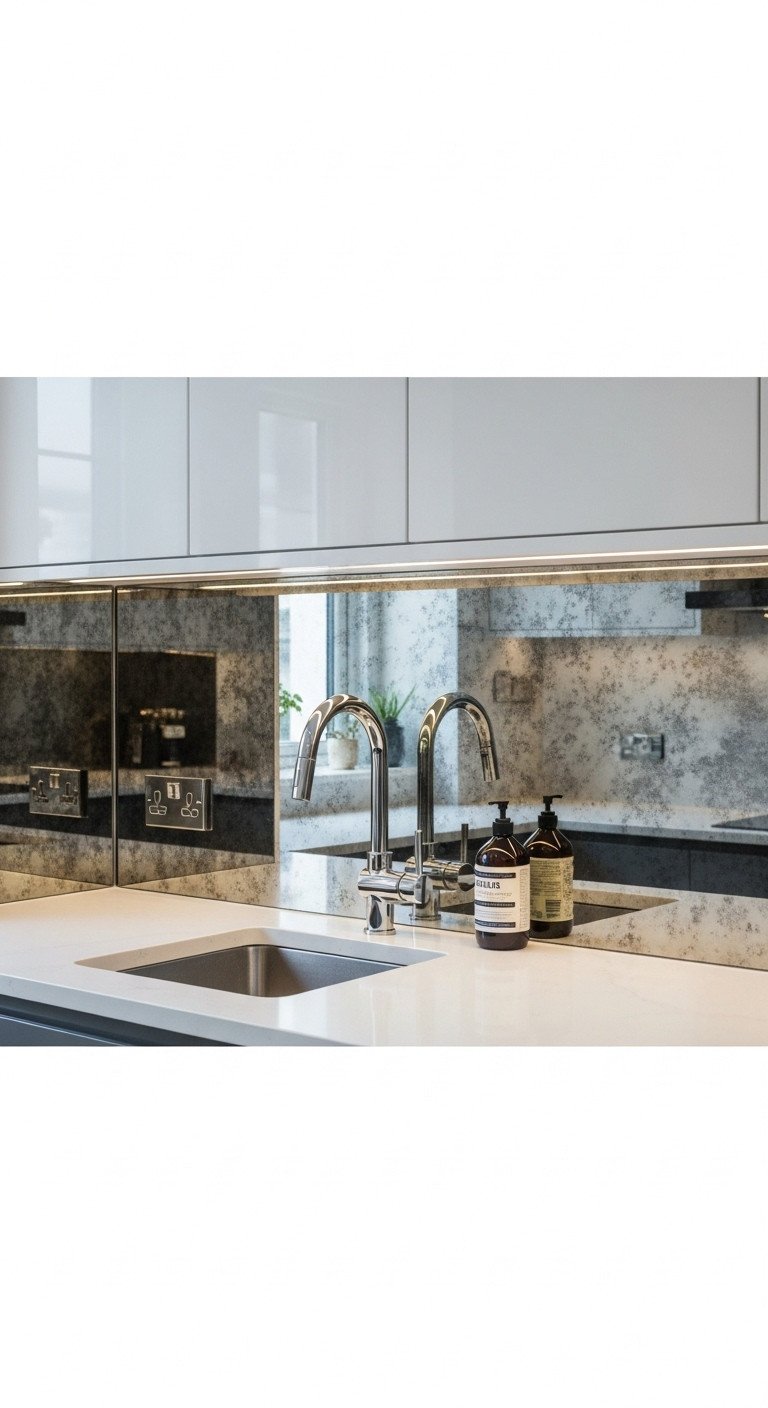
Pin this daring design trick to make a small space feel huge!
To dramatically make your galley kitchen feel wider, use a mirrored or high-gloss backsplash. These reflective surfaces bounce light and the view around the room, creating a powerful illusion of depth. It’s a bold move that can visually double the perceived width of your space, making it feel incredibly open and bright.
Materials Needed:
- Mirror panels (custom cut by a glass professional) or mirrored tiles
- Mirror adhesive (mastic)
- For tiles: Grout and tile installation tools
- For high-gloss acrylic panels: Panel adhesive and J-trim
Step-by-Step Directions:
- Choose Your Material:
- Mirrored Tiles (e.g., subway or antiqued): Easier to DIY install than a large panel.
- Solid Mirror Panel: Creates a seamless look but requires professional measurement and installation.
- High-Gloss Acrylic Panel: A modern, seamless, and more shatter-resistant alternative to glass.
- Prepare the Wall: Ensure the wall is perfectly smooth, clean, and flat. Any bumps will be magnified by the reflection.
- Professional Installation (Recommended for large panels): A glass company will measure, cut openings for outlets, and install a large mirror panel for you.
- DIY Tiling: If using mirrored tiles, apply them just like regular tiles using a special mirror-safe mastic. Grout the joints carefully.
- Clean and Admire: Once installed, the effect is immediate. The reflection bounces light everywhere and creates a powerful illusion of a much larger space.
Lesson Learned: If a full mirrored backsplash feels too bold, consider using high-gloss subway tiles instead. They provide a similar light-bouncing effect in a more subtle way.
13. Add Toe-Kick Drawers for Hidden Storage
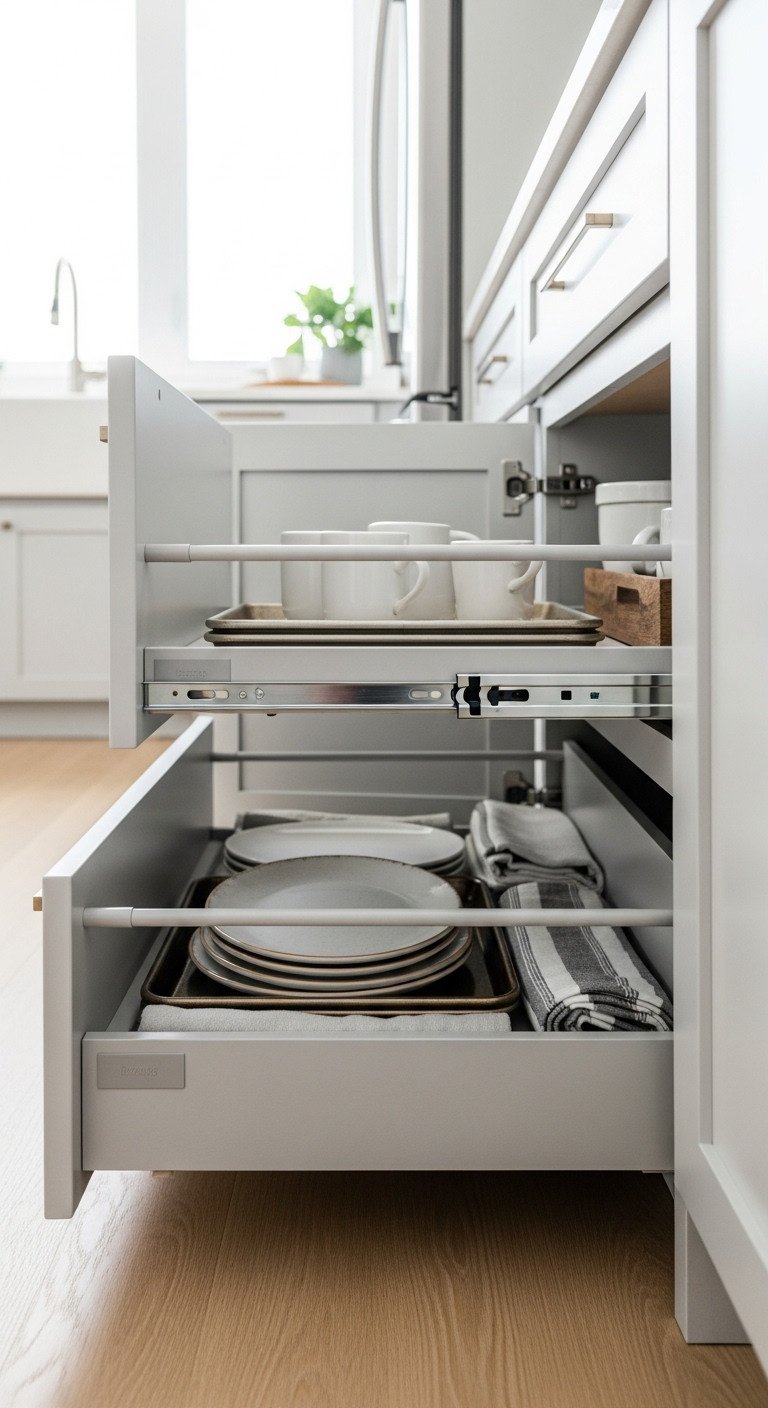
Save this genius idea for secret storage!
Looking for a truly innovative way to find more storage? The space behind the toe-kick at the bottom of your base cabinets is usually wasted. By installing shallow, hidden toe-kick drawers, you can create the perfect spot for flat items you don’t use every day, like baking sheets, serving platters, or extra linens.
Materials Needed:
- Retrofit toe-kick drawer kit or drawer slides and plywood to build your own
- Cordless drill and bits
- Jigsaw or oscillating multi-tool
- Measuring tape
- Wood glue and screws
Step-by-Step Directions:
- Assess Your Cabinets: Check if your base cabinets have a removable toe-kick board and enough clearance underneath (you need about 4 inches of height). This works best on modern, frame-less style cabinets.
- Remove the Toe-Kick: Carefully pry off the thin toe-kick board from the front of your base cabinets.
- Build the Drawer Box: Using a pre-made kit is easiest. If building from scratch, construct a simple, shallow box out of half-inch plywood that is slightly narrower than the opening.
- Attach Drawer Slides: Mount the drawer slides to the bottom of your cabinet base (you may need to add wood blocking for support) and to the sides of your drawer box.
- Create the Drawer Front: Attach the original toe-kick board to the front of your new drawer box. You can install a discreet, touch-latch mechanism so it pops open when you press it with your foot, maintaining a seamless look.
- Store Smart: Use these shallow drawers for items you don’t use every day, such as baking sheets, serving platters, emergency supplies, or extra kitchen linens.
Pro-Tip: This is a more advanced DIY project. If you’re not comfortable with custom carpentry, show this idea to a handyman or cabinet maker—they can often build and install these for you.
Key Takeaways: Your Quick Guide to a Better Galley Kitchen
- Manipulate Light & Reflection: The number one rule is to make the space feel brighter and bigger. Use light paint colors, under-cabinet lighting, and reflective surfaces like a glossy backsplash to bounce light around the room.
- Think Vertically: Draw the eye upward to combat the narrow, horizontal “tunnel effect.” Use floating shelves, tall cabinets, or a wall-mounted pot rack to utilize wall space and create an illusion of height.
- Prioritize a Clear Walkway: Every inch of floor space matters. Opt for low-profile hardware, consider a counter-depth refrigerator, and use a flexible rolling cart instead of a permanent island to keep the main thoroughfare clear.
- Create a Destination: Don’t let your kitchen end in a blank wall. Make the end wall a focal point with bold art, an accent color, or functional storage to give the space a sense of purpose and make it feel more intentional.
- Combine Function & Style: In a small space, everything should be both useful and beautiful. Choose a washable runner that adds personality, display attractive cookware on a pot rack, and decant pantry staples into nice jars on open shelves.
People Also Ask About Galley Kitchens
How can I make my galley kitchen look wider?
To make a galley kitchen look wider, focus on horizontal lines and light. Use a light color palette on walls and cabinets, install a reflective or glossy backsplash, and consider open shelving on one wall to reduce visual weight. Running floor planks or tiles horizontally across the narrow width can also trick the eye, creating a sense of spaciousness.
Are galley kitchens outdated in 2025?
No, galley kitchens are a classic, highly functional layout that is not outdated. In fact, they are celebrated in modern design for their ergonomic efficiency and space-saving footprint, making them a popular choice for apartments, condos, and small homes where maximizing every square foot is essential for a smart layout.
Can you put an island in a narrow galley kitchen?
It’s generally not advisable to put a fixed island in a narrow galley kitchen. You need at least 36-42 inches of clear walkway on all sides. A much better alternative is a narrow, rolling kitchen cart that provides the extra storage and prep space of an island but can be easily moved out of the way when needed.
What is the best lighting for a galley kitchen?
The best lighting for a galley kitchen is a layered approach. First, use a bright, flush-mount ceiling fixture for overall ambient light. Second, and most importantly, install LED strips under all upper cabinets for bright task lighting on your countertops. Finally, if you have an open end, a stylish pendant light can serve as an accent.
Final Thoughts
Your galley kitchen doesn’t have to feel like a compromise. By embracing its unique layout and using a few of these smart, space-savvy ideas, you can transform it from a narrow walkway into the stylish, hardworking heart of your home. Remember, a well-designed small space can be just as beautiful and far more efficient than a large one.
What’s the first change you’re excited to make in your galley kitchen? Share your plans in the comments below.
Last update on 2025-12-14 at 08:08 / Affiliate links / Images from Amazon Product Advertising API
